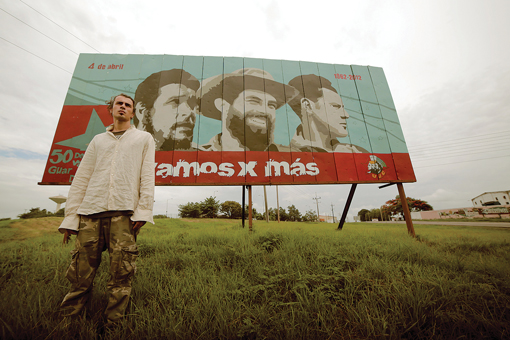Halfway between the Cuban towns of Martí and Baracoa, Cuban and Italian filmmakers José Balboa and Desiderio Sanzi plug a hole in the gas tank of their Russian Ural sidecar motorcycle with a glob of powdered deodorant and super glue. It’s a temporary fix for the machine that will carry them across all 15 Cuban provinces.
That scene in Ahora Sí Llego! (Now I Will Arrive) sums up the filmmakers’ determination to show a side of the country that few outsiders see. Inspired by Che Guevara’s legendary 1952 motorcycle trip though Latin America, the 93-minute film is a visually stunning journey through Cuba’s countryside.
But it is also a tribute to the variety of Cuban artistic collectives and institutions flourishing in the hinterland. The journey is interspersed with interviews with artists who produce some of Cuba’s often overlooked folk art, such as traditional wood and stone carvings, as well as modern forms of creative expression, such as performance art and animation.
View a slideshow of images from the film.
“Cuba is more than just La Habana,” Medardo Teunto Albóniga, an art teacher in Matanzas, tells the filmmakers. But they may be knocking on an open door. The film premiered in Havana in December and was supported by some of the government’s key cultural institutions: the Consejo Nacional de las Artes Plásticas del Centro de Desarrollo de las Artes Visuales (National Council for the Visual Arts at the Center for Development of the Visual Arts) and the Instituto Cubano del Arte e Industria Cinematográficos (Cuban Institute of Cinematographic Art and Industry).
But the most striking aspect of Ahora Sí Llego is the glimpse it provides of the island. “It is Cuba—no filters, completely authentic,” Sanzi says, adding that it portrays “a world that is disappearing.” That world is a tight-knit community that finds ingenious ways to live and create with limited means.
This world view is present in every scene—much of the film is shot from the moving motorcycle, and the bouncing, dusty footage adds a cinema verité dimension to the work. The name “Ahora Sí Llego,” a stranger’s comment during one of the many motorcycle repairs, captures the hopeful and romanticized view of Cuba that inspired the film: “We had a broken motorcycle, very little money; we were hungry and tired,” says Sanzi, “but we had a lot of heart, and the promise of the next province.”
View a trailer for Ahora Sí Llego!




